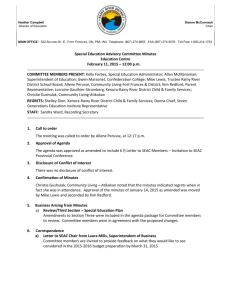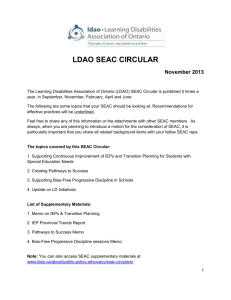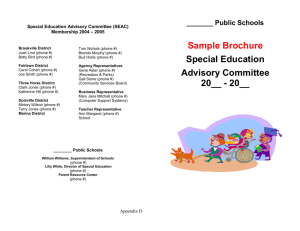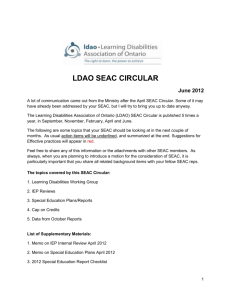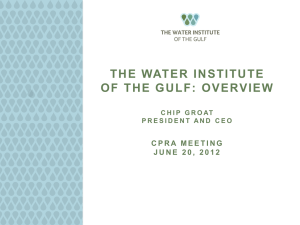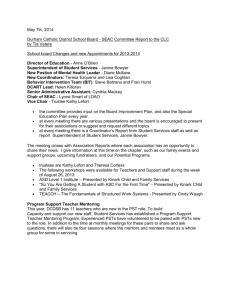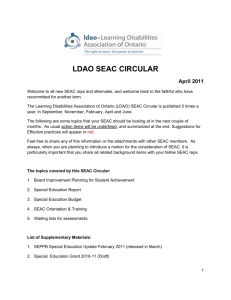President's Message - Society for Electroanalytical Chemistry, SEAC
advertisement
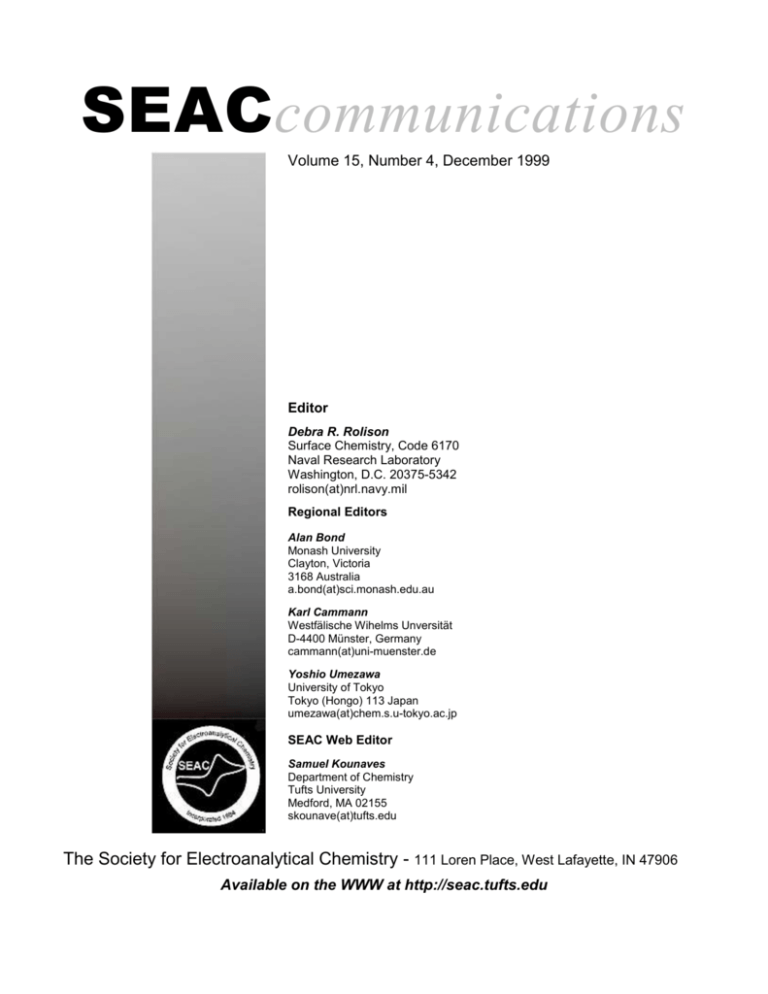
SEACcommunications Volume 15, Number 4, December 1999 Editor Debra R. Rolison Surface Chemistry, Code 6170 Naval Research Laboratory Washington, D.C. 20375-5342 rolison(at)nrl.navy.mil Regional Editors Alan Bond Monash University Clayton, Victoria 3168 Australia a.bond(at)sci.monash.edu.au Karl Cammann Westfälische Wihelms Unversität D-4400 Münster, Germany cammann(at)uni-muenster.de Yoshio Umezawa University of Tokyo Tokyo (Hongo) 113 Japan umezawa(at)chem.s.u-tokyo.ac.jp SEAC Web Editor Samuel Kounaves Department of Chemistry Tufts University Medford, MA 02155 skounave(at)tufts.edu The Society for Electroanalytical Chemistry - 111 Loren Place, West Lafayette, IN 47906 Available on the WWW at http://seac.tufts.edu President’s Message More Reflective than the Average Mirror! I am hearing, seeing and reading about the next presidential race for the White House almost daily now. This is a time of year for contemplation, so it is appropriate to stand back and look at the SEAC leadership and membership in the same way that the Nation is looking at presidential candidates. Let us do this in the context of potential planks in party platforms. Abortion—I definitely come down on the side of ProChoice here. If you look at it in an early stage and can clearly see that it is malformed, I say put an end to it and try again. Polish the electrode, change the electrolyte, raise the temperature, lower the temperature, but don't accept malformed voltammograms (remind me to tell you a quick story about that word, "voltammetry"). Character of the Leadership—Pete Kissinger's descriptions of the origins of SEAC in WETS, and Debra Rolison's news items on the social habits of prominent members leaves one with the immediate impression of an unhealthy character at the core of our organization. Let the world not be hasty in judgment. The occasional imbibition of a wee dram among friends and colleagues is a sign of a collegial and cooperative bunch. A healthy society communicates, and progress is thereby made. Don't Ask, Don't Tell—I support this policy that we have had for over a decade now. There is no reason to shun colleagues because they once did a cold fusion experiment. However, because it is a sensitive issue in some circles, we do not ask for this information on the membership application. Education Reform—Serious business, this. Of course, at the graduate level, we are in great shape. Hail to Bard and Faulkner. The undergraduate program is not as healthy. I would guess that more electrochemistry is taught, at the undergraduate level, in a Biology curriculum than in Chemistry. When we teach it, typically in second-term Freshman year, it is all about cells and algorithms to calculate potentials that leave a permanent ambiguity about signs, as in "+" and "-". Why is this? Do you suppose the same ambiguity exists in Accounting classes? Colleague McCreery has analyzed this, and perhaps he could contribute an essay on this in a future issue. Security—Security rests on detection. My policy is that all detection limits should be specified twice - once as a mass detection limit, once as a concentration detection limit, and always in mole and molar units for fluid solutions. Campaign Finance Reform—I have a sound policy here. I returned Jim Cox's (Nominating Committee) phone call after 5 p.m. at 5 cents a minute. Thus, my candidacy cost 15 cents. That seems about right, doesn't it? International Relations—I fully support ESEAC, and look forward with almost youthful glee to our meeting in the summer. This will be a celebration, for sure. Don't miss the Abstract deadline! Of course, as with the Pennsylvania Avenue crowd, the President of SEAC can do very little without the vision and energy of a dedicated band of like-minded electrochemists. One of the most energetic, imaginative, and influential members, Andy Ewing, is resigning as Secretary. Andy, the organization has grown and been strengthened by your membership campaigns, and we are indebted to you for that. You also managed to put our membership records in an accessible form. Your superb organizational skills, and the skills of some of your closest coworkers named Lena, are going to be missed. I will miss your passion and energy dedicated to the cause of promotion. Thank you for all of your service. Steve Weber Editorial Holiday Greetings, Ye Merry Surfers of SEAC! …and now to the last task before I figuratively fling the final 1999 edition of SEAC Communications out the door and on its wintry way, first to SEAC’s Webmeister, Sam Kounaves, and then to your waiting fingertips. Writing the editorial is the last task because you, my fellow electro(analytical)chemists, set the tone for the most part and I need but follow and reflect. As befits the end of a year, SEAC’s members are blending some reflection on what was (many thanks to Pete Kissinger for his fireside tale of the genesis of SEAC…to be read accompanied by fine port and spiced walnuts) with an assessment of where we might go (El Prez Weber for President!…to be read with your potentiostat humming nearby). And in keeping with the exchange of what was for what will be: remember to return your ballets for the SEAC Election of Officers and new members of the SEAC Board of Directors. The candidate slate is reprinted for your perusal at the end of the issue. As part of the changing of the guard, all too typical of year’s end, SEAC-wide (and personal) fond farewell—for now—to Andy Ewing [age(at)psu.edu]. Andy, to you and Lena: reams of thanks! especially for addressing SEAC’s need for a new directory and membership database. As homework for year’s end: ponder on the next evolution of SEAC’s website. Is it now time to create a member-only, passwordkeyed entry level on the homepage? The Board of Directors has expressed an interest in the past in making the membership directory available electronically to the members, but with the recognition that that access should be member-only. And in this issue we have an open announcement for a postdoctoral position, but there may be times when these and related announcements are preferred to be directed just to the SEAC membership. So think about ways to make the SEAC website even more useful to you. Contact the Officers and Board of Directors of SEAC with your thoughts on this matter before the Board Meeting at Pittcon in March, or relay your electrons to either Sam Kounaves skounave(at)tufts.edu or rolison(at)nrl.navy.mil. Remember: let your electrons do the walking! Keep in touch with your fellow SEAC surfers (and Your Editor)…because I will make it up as I go if I have to!! May Your Electrons Be Merry and Bright!! Debra Rolison ____________________________________ Postdoctoral Opening!! —From Jim Rusling / U Conn We anticipate a postdoctoral opening in April or May 2000, in our "Electrosynthesis in Microemulsions" project. A Ph.D. in Chemistry or Chemical Engineering and a high level of experimental skills in both organic chemistry and electrochemistry are required. The position will involve organic synthesis, electrosynthesis, and physical organic electrochemistry on catalytic polymer films on carbon electrodes in microemulsions (for an example, see D.-L. Zhou, C.K. Njue, and J.F. Rusling, "Covalently Linked Scaffold of Cobalt Corrins on Graphite for Electrochemical Catalysis in Microemulsions", J. Am. Chem. Soc. 1999, 121, 2909-2914). Candidates must show experience in the required areas by authorship of research publications in English-language journals. Candidates may contact me by email with their resume (unencoded, please) and publication list. Professor James F. Rusling Department of Chemistry University of Connecticut Storrs, CT Jrusling(at)nucleus.chem.uconn.edu ____________________________________ Pittcon Travel Grant to SEAC Student Member Announced!! —The Pittcon Travel Award Committee is pleased to announce that Allen C. Templeton, who is racing to the finish of his Ph.D. at the University of North Carolina (in the Royce Murray wing of Kenan), was awarded the 2000 SEAC Travel Grant sponsored by EG&G Instruments, Princeton Applied Research. Stay tuned to the pre-Pittcon issue to find out when, where, and what Allen will be presenting at Pittcon 2000 in New Orleans. ____________________________________ SEAC Items of Note—Noted in Passing: ELECTROCHEMICAL NUPTIALS !! Jerry Lenhard [an infamous name among anyone who has ever worked with chemically modified electrodes…`cause if you haven’t cited his papers with Royce Murray from the late 1970s, you should have], who, when he isn’t walking down the aisle, blends photons and electrons at Kodak (jlen(at)kodak.com) made the mistake of letting your Editor get her hands on proof of his recent (3 September 1999) marriage to Christine Rossi. Health and am attempting (!) to use electroanalytical techniques to study the chemistry of anxiety in the brain (an emotion with which assistant professors are well acquainted).” She can be reached at: ama(at)chem.psu.edu —clearly, Anne has found the *right* society to join!!— David Hatchett (Ph.D. University of Utah) has fled the humidity of Atlanta—finishing his postdoctoral sojourn with Art Janata and Mira Josowicz—for the dry heat of the desert as a new faculty at the Department of Chemistry at the University of Nevada-Las Vegas. Send your spare water molecules to: dahatchet(at)ccmail.nevada.edu Big-Time Trouble on the Front Ridge: Another Victim of the Creeping Epidemic of Electroanalytical Chemists Morphing into Chairs!!! —Carl Koval (University of Colorado) reports from Boulder, CO, that he, too, needs condolences and chocolate from SEAC surfers. Carl admits that he, too, is now Chair of his Department of Chemistry, thereby succumbing to an ominous trend along the Rocky Mountain’s Front Ridge that has also afflicted his fellow SEACers (and chairs) Dan Buttry (University of Wyoming) and Mike Elliott (Colorado State University). Carl notes: “At least, Buttry, Elliott and I have a lot in common when it comes to whining about our jobs…” Chocolate-scented electrons may be addressed to: carl.koval(at)colorado.edu Following the wedding ceremony, Jerry and Chris’ reception was held at a local Italian winery, for which example of excellent taste, Jerry’s friends attribute solely to the bride! —Jerry, all the best to you and Chris (…does she know of your Tar Heel legend as the Yumbo Rabbit???)— ____________________________________ SEAC on the Move! —Anne Andrews is the most recent addition to the chemistry faculty at Penn State (?State Penn?) and an even more recent member of SEAC. Anne adds: “I 'escaped' from a senior staff fellow position at the National Institutes of And the Epidemic Hits the Eastern U.S.!! —Dick Durst has accepted Head of the Department of Food Science & Technology at Cornell University, Geneva, NY. He adds: “I've been chair since July 1st, and "loving" every minute!! Actually, I just wanted to prove that an electroanalytical chemist could do anything— even run a food science department!” Dick has also added the following tag to his e-messages: “Being the chairman of an academic department is like being the shepherd for a flock of cats." —Send your condolences (and kitty treats) to— rad2(at)cornell.edu _______________________________________________________________________________ SEAC Musings 1999—How and why we started Pete Kissinger President, BioAnalytical Systems, Inc. I appreciate Debra Rolison’s invitation to recall the motives and means for the founding of SEAC, which is now a 15-year-old event. We are in the middle teenage years, a troublesome time for many of us. How far into the new millennium can we expect SEAC to last? In the early 1980’s, it became quite clear to me that electroanalytical chemistry was not included in the substantial number of awards that recognized accomplishments in analytical chemistry. There were, of course, awards for general excellence in analytical chemistry and instrumentation. Included among the winners were a few who were specifically recognized for their accomplishments in electroanalytical chemistry. On the other hand, there seemed to be an increasing number of more specialized awards that called attention to various forms of spectroscopy and chromatography. I wondered if the absence of a more faradaic award weakened our field, or at least didn’t give it proportionate attention. As a second point, I had in mind the possibility of doing something to recognize the memory of my dissertation advisor, Prof. Charles N. Reilley. I began to realize how fleeting the name recognition for scientists can be. My own graduate students didn’t recognize the names of those chemists who were my heroes as a graduate student only 15 years earlier. Things were moving so fast that papers published more than 5 years ago were totally forgotten (and often unknowingly repeated). In any event, Charlie Reilley was one of the great minds of 20th century analytical chemistry, easily in the top 20 for this ten-decade period. I thought he should be remembered. The third leg on this stool came from my conclusion that the Electrochemical Society (ECS) really did not provide an attractive home for us. The physical chemists, materials science people, and solid-state physics people had pretty much made it their home. Many of us are ECS members because we view these topics as fundamentally supporting our objectives, even if they do not define our objectives. The ECS is a good group. It is just not our group. The result of these three concerns of mine was the Reilley Award and the founding of SEAC. An ACS award was considered first, but the expense and bureaucracy of it was unattractive back then (early 1980’s). Other options were considered. SEAC was really founded as a container for the Reilley Award and a means to administer it without prejudice. As luck would have it, the Pittsburgh Conference became quite interested in attracting more symposia on electroanalytical chemistry and champions of this on the Pittcon Committee welcomed the concept of SEAC, just as they had earlier embraced affiliated groups such as the Coblentz Society. It was clear that the electroanalytical community was large enough to attract a crowd sufficient for Pittcon to “invest” in supporting such a symposium financially. Pittcon thus became a logical “home” for the Reilley Award and SEAC a logical means of organizing the supporting symposium. Thus there has been a symbiotic relationship between Pittcon and SEAC since 1984. It was impossible to start a group like SEAC alone. The name came directly from the American Association for Clinical Chemistry (AACC). I envisioned an international group and therefore eliminated the “American.” It is the Society for Electroanalytical Chemistry and not the Society of Electroanalytical Chemists. It was deemed to be a group that would be inclusive and would welcome those who use our art and not only those who develop it. There was never the intention that SEAC be an American group. Nevertheless, it was gratifying when certain Europeans later stole the name and invented ESEAC, a rather intemperate group that admitted even Irishmen. Launching SEAC was very much a team effort. Out of the starting gate, I first tested the idea on Profs. Bill Heineman and Larry Faulkner. Passing that test, others were enlisted, including Joe Maloy, two Osteryoungs, one Bard, one Anson, Mark Wightman, Stan Bruckenstein, Dennis Evans, Ted Kuwana, Dennis Johnson, Steve Weber, Royce Murray, and Ralph Adams. All of these people ultimately constituted the first SEAC Board of Directors. Along the way, an informal meeting was held in the coffee shop at the Hyatt Hotel in Indianapolis in May of 1983 at the International Symposium on Electroanalytical Chemistry sponsored by BAS. SEAC was to have some genetic relation to an earlier group from the 1960s, The Western Electroanalytical Theoretical Society (WETS), a 1960s discussion group focused on electrochemistry and politically incorrect activities. WETS was a thirsty society which was itself derived from an earlier group, the SCSD, the San Clemente Surfing and Discussion Society. The SC-SD was before my time. I was doing electrochemistry for my high school science fair project, but these guys were unaware of it. I was reluctant to publish and certainly could not send them an email. They knew I was below the legal drinking age and therefore refused to invite me to join. SC-SD was at the height of the cold war. Thoughts of nuclear weapons, Sputnik, and jet fighter aircraft led to a need for beach therapy with beer and sun. Women were not chemists in any significant numbers back then and the concept of a “graduate student from Shanghai” was totally unimaginable. Many things have improved in recent years. I’ve only been able to get snippets of information from SC-SD members Bob Osteryoung, Fred Anson, Ralph Adams, Dick Buck, and the longdeparted Willy Reinmuth, Don Davis, Charlie Reilley, and Dave Mohilner. SC-SD led to the first Gordon Conference on Electrochemistry in 1964. For you mathematicians, that was 35 years ago! Chronopotentiometry was king. SEAC further required a newsletter to follow the original INTERFACE newsletter that was published first at the University of North Carolina, then at the University of Kansas, at Michigan State, and at Purdue. The editor of this newsletter was Faraday Farbunkle, an inspiring character I had the pleasure of first meeting in 1967 on a canoe trip south of Chapel Hill. A “Steering Committee” was established to guide SEAC’s formation. This consisted of Faulkner, Heineman, Johnson, Kissinger, Maloy, Osteryoung (J.) and Weber. The first newsletter was published February 1, 1984. Allan J. Bard was selected as the first Reilley Awardee and the Award was presented Monday, March 5, 1984 at the Pittsburgh Conference in Atlantic City, New Jersey. The four principal officers of the new society were Bill Heineman (President), Joe Maloy (President-Elect), Janet Osteryoung (Secretary), and Larry Faulkner (Treasurer). Bill Geiger edited the newsletter. Joe Maloy provided the inside track to the Pittsburgh Conference via John Jackovich. Tom Kissinger registered us as a nonprofit organization since taxes seemed (even then) to be undesirable. One can only hope that Faulkner’s tenure as the first SEAC Treasurer is now paying off for him in budgeting for the University of Texas at Austin (a “few” powers of ten larger than SEAC’s endowment, but the concept is similar). Being an academic, I recognized the pervading suspicion of the motives of business people and (at that time) the rise of the notions of “conflicts of interest” or even the “perception of conflicts of interest.” (This still strikes me as a wild notion in a society where all progress basically flows from a confluence of interests.) To avoid such perceptions (and realities), SEAC could not have been founded or sustained without the enthusiastic support and enormous amount of donated labor of quite a number of people, as evidenced by the long list of SEAC directors and the shorter list of officers and newsletter editors over the years. The Reilley Awardees continue to be a real credit to the Society, as do the Young Investigator Awardees. It doesn’t take much imagination to conclude that SEAC was also responsible for the establishment of an ACS Award in Electrochemistry. The recognition is good for the field and we are now competitive with the chromatographers and spectroscopists in this regard. While we have recognized the name of Prof. Charles N. Reilley, I suspect that very few of us can recall his contributions. I’ve also mentioned the late Don Davis and Willy Reinmuth. I should have mentioned Don Smith as well. The number of SEAC members who know the contributions of such individuals to our science is not very many. The good news is that electroanalytical chemistry is alive and well and is now contributing in so many fields, including materials science, sensors, neuroscience, diagnostic medicine, batteries, corrosion, and education. —Charlie lives on, Pete…thanks to you and SEAC’s founders…those of us who had the infamous CyaNide Reilley for courses at Chapel Hill will never forget the privilege of being present when Charlie was waxing brilliant!— _______________________________________________________________________________ Award Nominations Still Solicited for SEAC’s Y2K+1 Awardees! SEAC is responsible for the establishment and the administration of the Charles N. Reilley Memorial Award and the SEAC Young Investigator Award. Sponsored by Bioanalytical Systems, Inc. and administered entirely by SEAC, the Reilley Award recognizes an active researcher who has made a major contribution to the theory, instrumentation, or applications of electroanalysis. The Young Investigator Award, sponsored by Cypress Systems, recognizes accomplishments by a researcher who is within the first seven years of his or her career. In conjunction with the presentation of these awards, SEAC arranges an Award Symposium and an informal reception in honor of the Awardees at Pittcon. In this way, SEAC serves as the focal point for analytical chemists who wish to exchange ideas about electroanalytical chemistry at the conference. All nomination materials for the Reilley or Young Investigator Awards will be retained by SEAC. Once nominated, an individual will be considered for three years without being renominated. The submission of any additional supporting information or a renomination is welcome at any time, but the decision on the 2001 Awards will be based upon the material that is available to the Award Committee by 1 March 2000. —Charles N. Reilley Award— Nominations for the Y2k+1 (2001) Reilley Award should include a letter of nomination describing the individual's significant contributions to electroanalytical chemistry, at least two seconding letters of support, and a curriculum vitae for the individual. —Young Investigator Award— For the 2001 SEAC Young Investigator Award, nominees must be within seven years of obtaining their Ph.D. or other terminal degree at the time of nomination. Candidates may be nominated by any member of SEAC. Nominations should include a letter describing the individual's promise in the area of electroanalytical chemistry, at least one seconding letter of support, and a curriculum vitae for the individual. Requests for further information or submissions of nominations for all awards should be directed to: Professor RICHARD M. CROOKS SEAC Awards Committee Department of Chemistry Texas A&M University P.O. Box 30012 College Station, TX 77842-3012 Tel: 409-845-5629 FAX: 409-845-1399 E-mail: crooks(at)tamu.edu ____________________________________ Day 1. Left SLC at 6:00 a.m. pronto, taking the YES, backroads to check out rural Utah towns. Lots of questions from the backseat about polygamist cults (??). Arrived at Bryce Canyon (~9,000 ft elevation) in early afternoon. Great weather. Descended 1000 ft into the canyon, hiked 4 miles across, ascending up the other side through countless switchbacks (lots of complaining at this point), and returning five hours later along the northwest rim. Everyone annoyed at length of hike. Great time with Carol K, rolling medium-size boulders off the canyon rim in the general direction of foreign tourists walking the trails below! Apparently, we were the only Americans in the canyon, the other several hundred or so tourists being friendly Germans and French (with much better cameras than our disposables). Checked into the luxurious White Pine Motel, complete with café specializing in home-made pies and real Utah salt. THE CONTINUING SAGA CONTINUES! The Further Adventures of Horseshoe Henry —Brought to you by the man himself— Hole-in-the-Rock Expedition Readers—I drew trail guide duty last October, leading Carol Korzeniewski and Debra Rolison through the southernmost parts of Utah on a two-day jaunt. Rumor has it that this is the first time they have been outside the laboratory in years. Nevertheless, I’m pleased to report that they are excellent adventurers, complaining only periodically, but not excessively loud, about sore feet and hunger. Here are my journal entries for those two days. HH Disposable camera at work: Carol Korzeniewski (Texas Tech University), left, and Your Editor *before* Horseshoe Henry hiked our asses down one side of Bryce Canyon (what a backdrop!), and up the other on a beautiful day in early October. A great time was had by all! Day 2. Left the White Pine Motel at 6:00 a.m., stopping for the normal breakfast fare of coffee and a "nano"-biscuit—the magnitude of breakfast was a source of complaint for the next 10 hours. Drove for an hour to Escalante (location of a 900-year-old Anasazi settlement), and headed 57 miles south on a remarkably rough dirt trail to the famous Hole-in-the-Rock** (HITR). Stopped at Devil’s Garden to play on giant mushroom-shaped rocks. Fantastic mountain and desert scenes the entire road. Posed for pictures at Carcass Gulch. After three hours of driving, and about 10 miles short of the HITR, the trail disappeared into slickrock and loose sand. At one critical point, it was necessary for Carol K and Debra R to construct a rock ramp in order to get the jeep from one boulder to the next (I supervised construction while drinking a Coors and have to admit that these gals are unexpectedly good at roadwork). Apparently they worked up an appetite at this point—the conversation about food (specifically, the lack of) turned a bit ugly at this point. Made it to HITR, and descended on foot down to Lake Powell. The visitors didn’t venture all the way to the bottom, apparently worn out from the earlier roadwork. Finishing off the last Coors, I requested that Carol K drive the trail back to Escalante—a terrifying experience, mainly spent airborne. Survived the last hours on a tiny bag of pistachios (Debra R's emergency kit!). that claim with post-Bryce Canyon wearies and Your Editor couldn’t stop laughing for fifteen minutes. —…but that’s just one man’s view…— Hole-in-the-Rock (above): seen from the Utah side (after hours of dirt, rocks, high desert scrub, and not a creature in sight). HH at play in the Devil’s Garden. This place is *cool*—our fifteen-minute stop to take a gander turned into 90 minutes of climbing and hide-and-seek. Hole-in-the-Rock (below) from the inside: with Lake Powell (and powerboats!) as the endpoint of the journey down the notch. 1 2 Escalante Bryce Canyon Utah Arizona Hole-inthe-Rock Colorado River Glen Canyon Looks suspiciously like a map, no? But don’t worry…HH cribbed this from the paper place mat underneath our breakfast of coffee and “nano”biscuits. PS: fantastic trail guide though he is (if one is an air plant and doesn’t require solid food), HH left out the *real* lowdown on that real Utah salt…it was so natural, so superior to other table salts because it was completely free of chemicals !!! Combine **Historical/Geological Note: HITR is exactly what it sounds like, a good size hole in the east wall of Glen Canyon that you could drive a semi through. Once inside HITR, there is a narrow notch, 3/4 mile long, that descends about 1800 ft down to the shore of Lake Powell. Mormon pioneers used HITR in 1879-80 as a passageway during colonization of the southeast corner of Utah (the real "Hole-in-the-Rock Expedition"). It took the pioneers 45 days in the winter to negotiate the 57 miles that now takes 3 hours with high-clearance 4-wheel drive. The Oct ’99 trip was HH’s third attempt to reach HITR, the first two failed due to flooding (’96) and a late spring blizzard (’99). _______________________________________________________________________________ OUR CONTINUING AND HIGHLY POPULAR SEAC FEATURE — Name That Electrochemical Nerd * !! The first official correct guess (as determined by directly contacting the Electrochemical Nerd, a.k.a. El ExEditor Extraordinaire (a.k.a. Dick Durst ), Professor of Chemistry at Cornell University, Geneva) was made by Boston College’s Ted Light, who is rumored —…fear not, Dick…you will be reminded to muse away…just ask our overly tardy Reilley awardees (yes, *you*, Al)…I *never* forget to nudge— —Pictured below is this issue’s entrant in “Name that Electrochemical Nerd”. Again, the first correct guess (as determined by directly contacting the pictured-herein EN) will win an autographed copy of the EN’s latest reprint.— to have won an autographed copy of one of the EN’s latest reprints. In message Wed, 15 Dec 1999 16:43:25 –0800, Richard A. Durst writes: Dear Debra—Thanks for your "kind" words about me being the "Loser-Electrochemist du jour" (even though it's probably on the mark). However, while I wear my nerdiness with pride, I can't claim, or accept, the epithet of "electrochemist" since I am truly of the electroanalytical school (even though my alma mater—MIT—has long since done away with its major in analytical chemistry, much to their narrow-mindedness, and quite possibly my impact on the school. Anyway, I once again must decline your generous offer to publish my editor's reminiscences in the newsletter. My newish duties as department chair have taken their toll on my "free" time; which actually never existed even before the chairmanship. Actually, I have on my to-do board the item: "SEAC muse". So this job is never far from my consciousness; albeit this is another questionable attribute in my present condition. However, I really do plan to write something for you in the upcoming century. In the meantime, I wish you a very merry Christmas and electric New Year, Dick Dept of Food Science & Technology Cornell University Geneva, NY 14456-0462 rad2(at)cornell.edu —…and please send in your candidates (and mystery photographs) for next issue’s entrant in “Name That Electrochemical Nerd”!!— * a.k.a. “Loser-Electrochemist!”, Communications, 1998, 14 (1). see SEAC _______________________________________________________________________________ Plan your attendance accordingly! GORDON RESEARCH CONFERENCE ON ELECTROCHEMISTRY 16-21 January 2000 Four Points Sheraton Hotel—Ventura Harbortown Resort Ventura, California http://www.grc.uri.edu/programs/2000/elecchem.htm …oops…check with Neal Armstrong [nra(at)u.arizona.edu]—the subscribed that he may be wait-listing new applicants… conference is so _______________________________________________________________________________ Plan your attendance accordingly!—Part Deux BIOSENSORS 2000—6TH WORLD CONGRESS 24-26 May 2000 Hyatt Regency—San Diego, California http://ww1.elsevier.nl:80/homepage/sag/biosconf/ _______________________________________________________________________________ Plan your attendance accordingly!—Part Drei ESEAC 2000 11-15 June 2000 Joint Meeting of the European Society for Electroanalytical Chemistry (ESEAC) and the Society for Electroanalytical Chemistry (SEAC) Bonn, Germany http://www-upb.ipc.kfa-juelich.de/eseac2000.htm ____________________________________ From the (E-)Mailbag futon days (a.k.a. cold fusion)…I will be sure to check out his progression from elements to molecules— —The members rattle their electrons— In message Mon, 11 Oct 1999 17:44:56 –0400, Harry Finklea writes: Dear Debra—I would like to offer a few comments on the latest SEAC issue (incidentally, the pdf format worked just fine— the image of Israel Rubinstein taking out a critical reviewer was worth the download time). First, books for discussion with non-chemists ... I suggest: Molecules at an Exhibition. Portraits of Intriguing Materials in Everyday Life, by John Emsley, Oxford University Press, 1998. I read a review of this book in Chemical & Engineering News, and on the strength of the review, bought the book via Amazon.com. I intend to use it as a source of anecdotes to spice up General Chemistry lectures. However, it does contain a number of issues which could excite or alarm the non-chemical humanist. Second, my congratulations and consolation to my colleagues who have accepted the position of Chair, Head, or Fearless Leader in their respective Departments. I have recently taken on the task of Director of Graduate Studies in our Dept, and have found it to be an administrative black hole with respect to research time. I can well imagine how their lives have been changed. Regards, —It bears repeating— In message Mon, 14 Jun 1999 09:08:15 +0200, Hendrik Emons writes: Dear Debra—Thank you very much for including our first information about ESEAC2000 into the recent Newsletter. I could print it without additional question marks (Southern German printers may be different from ours!). I will keep you informed about the meeting and hope to see you in Bonn. Best regards. Hendrik Environmental Specimen Bank Institute of Applied Physical Chemistry Research Center Juelich GERMANY h.emons(at)fz-juelich.de In message Mon, 18 Oct 1999 13:34:11 +0200, Bernd Speiser writes: Dear Debra—I just received the files of the number 3 Communications. NO (absolutely) NO spurious question marks in the postscript print-out. Southern German printers seem to be catching up to northern Germany ones now. Regards. Bernd Institut für Organische Chemie Auf der Morgenstelle 18 D-72076 Tübingen GERMANY bernd.speiser(at)uni-tuebingen.de Harry (a.k.a. a Voice from the Wilderness) Professor Director of Graduate Studies Department of Chemistry West Virginia University Morgantown, WV 26506-6045 finklea(at)wvnvm.wvnet.edu —Thanks for that holler from the Wilderness, Harry…I love Emsley’s The Elements (it kept me sane talking to physicists during chilly In message Mon, 18 Oct 1999 13:53:43 –0400, Debra Rolison writes: Dear Bernd—giggle! I thought that Herr Dr. Prof. Emons e-note might raise an appropriate response! Best. Debra _______________________________________________________________________________ Reminders to the SEAC Members —Join us! SEAC’s (still-but-soon-to-be-Past) Membership Chairman, Susan Lunte [Department of Pharmaceutical Chemistry; 2095 Constant Avenue, University of Kansas, Lawrence, KS 66047, USA. E-mail: lunte(at)hbc.ukans.edu] will now receive all NEW MEMBERSHIP APPLICATIONS and INITIAL DUES PAYMENTS. Remember: a membership form can be downloaded in either HTML or PDF format from the SEAC website [http://seac.tufts.edu/membership.html]. Any new members recruited by current members should send their completed applications directly to Susan. —Vote Early! In addition to sending out your holiday cards and filling out your SEAC membership renewal (*with* e-mail address, thank you very much!!), you will find a ballot for your vote in the 2000 SEAC elections. Our biennial selection of President-Elect, Treasurer, and Secretary is underway, as is election of three new members to SEAC’s Board of Directors for five-year terms (2000-2005). For your consideration is the following slate of candidates: Biographical Sketches of Candidates 1. President-Elect (to assume President-Elect status in July 2000 and a two-year term as President in July 2001) Mark E. Meyerhoff, Professor of Chemistry, University of Michigan. B.A. (Chemistry) Lehman College (CUNY System); Ph.D., SUNY-Buffalo; postdoctoral research, University of Delaware. His research interests are in the field of bioanalytical chemistry, particularly the development of new ion-, gas-, and bio-selective electrochemical sensors suitable for whole blood measurements of clinically important analytes. He also has active research programs in the areas of immunoassays and liquid chromatography. 2. Treasurer (to assume office in July 2000) Joseph T. Maloy, Associate Professor, Seton Hall University. B.A. (Mathematics) St. Vincent College; M.A. (Analytical) and Ph.D. (Physical Chemistry) University of Texas (with A.J. Bard). Interests: computer modeling of electrochemical and chromatographic processes; digital interpretation of current transients; statistical applications; chemical education. 3. Secretary (to assume office ASAP! Just ask Andy Ewing!) Susan M. Lunte, University of Kansas. B.S. (Kalamazoo College); Ph.D. (Purdue University); previous employment at Bioanalytical Systems and Proctor and Gamble. Interests: new methodologies for separation and detection of peptides, neurotransmitters, and pharmaceuticals in biological media; electrochemical detection in capillary electrophoresis. 4. Board Lou Coury, Direct of Research, Bioanalytical Systems, Inc. B.S. (Chemistry) Miami University; Ph.D. (Analytical Chemistry) University of Cincinnati; postdoctoral associate, University of North Carolina. Previous position, Duke University. SEAC Young Investigator Award in 1996. Present interests include editor of the journal Current Separations and New Product Development at BAS. Howard D. Dewald, Professor, Department of Chemistry and Biochemistry, Ohio University. B.S., University of Wyoming; Ph.D., New Mexico State University; postdoctoral research at the University of Cincinnati. Research interests are LCEC of plant phenols; stripping voltammetry for clinical, environmental, and forensic applications, electrochemical chaos; lithium-ion batteries. Jon Kirchoff, Associate Professor of Chemistry, and Medicinal and Biological Chemistry; B.A., SUNY-Cortland; Ph.D., Purdue University; postdoctoral associate, University of Cincinnati. Research interests are in bioanalytical and electroanalytical chemistry and include development of modified macro- and micro-electrode sensors, microelectrode of dimensions for intercellular measurements, detectors for capillary separations and spectroelectrochemical methods. Samuel Kounaves, Associate Professor, Tufts University; B.S./M.S, California State University at San Diego; Ph.D., Université de Genève; postdoctoral research at SUNY-Buffalo and Harvard University Medical School. Research interests include the development of microfabricated UME arrays and sensors and their application to environmental and analytical problems. Other interests include electrochemically-based sensors for in-situ planetary chemical analysis, detection of chemical biosignatures on Mars & the Jovian moons, and development of micro-ISEs for monitoring water quality on the International Space Station and human space habitats. William R. LaCourse, Associate Professor of Chemistry, University of Maryland, Baltimore County. Ph.D. (Analytical Chemistry) Northeastern University; postdoctoral appointment at Ames Laboratory; previous position, Scientist at Iowa State University/Ames Laboratory. Research interests include basic and applied research on hydrodynamic electroanalytical techniques in liquid chromatography and capillary electrophoresis, adsorption phenomena at noble metal electrodes, and advanced sample preparation techniques (e.g., microdialysis and pressurized-fluid extraction). Greg Swain, Associate Professor of Chemistry and Associate Department Head at Utah State University. B.A., University of Texas at Dallas; Ph.D. (Analytical Chemistry) University of Kansas; postdoctoral appointments: Space Power Institute, Auburn University and JSPS Postdoctoral Fellow at Tohoku University (SEAC Young Investigator Award in 199x). Research interests include the development and study of diamond thin-film electrodes, carbon electrode structure-reactivity relationships, electrode double layer structure, FIA-EC and LC-EC applications, and aluminum alloy corrosion in nonaqueous media. —and now a message from Jim Cox, Chair of the Nominations Committee (yes, there is a committee, not just Jim!) As stated in the Society’s By-Laws, suggestions for candidates can be made by SEAC members to the Nominations Committee at any time during the year—we welcome your input. The names of potential candidates can be forwarded to: coxja(at)miavx1.muohio.edu. The preparation of the next ballot will begin in late September 2000. _______________________________________________________________________________ Welcome to New (and Returning) SEAC Members!!! Abdel-Nasser M. Aly Kawde New Mexico State University David T. Mitchell Colorado State University Kevin Ashley CDC/NIOSH Alex R. Nisbet Ouachita Baptist University Lane Baker Texas A&M University Shawn Sapp Colorado State University Philippe Bühlmann University of Toyko Andrew F. Slaterbeck University of North Carolina-Chapel Hill Francis Burns University of Toledo Kevin P. Troyer University of North Carolina-Chapel Hill Michael R. Clager University of Cincinnati Walter R. Vandaveer IV University of Arkansas Jodie L. Conyers, Jr. University of Utah Gary S. Vardon OSMA Joshua Cooper University of Kansas Alexander Vaskevich Weizmann Institute of Science Philip W. Crawford Southwest Missouri State University Jeremy P. Wilburn University of Memphis Jun Cui University of Pittsburgh Bizuneh Workie Jackson State University Stacy Hunt DuVall Ohio State University Yungin Wu University of Pittsburgh W. Russell Everett University of Kansas Lin Xia Ohio State University David W. Hatchett University of Nevada-Las Vegas Alexander M. Yacynych Electropolymerization Technologies Zhongmin Hu Iowa State University Wei Zeng Seton Hall University Carol Korzeniewski Texas Tech University
